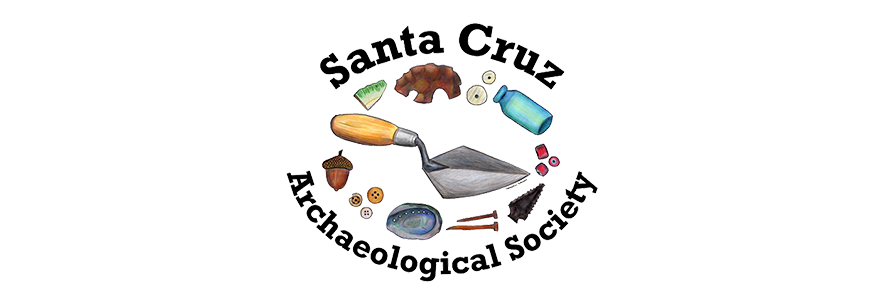Upcoming Events
In the Spotlight
- New SCAS Meeting Location: Elks Lodge!
- Scotts Valley Display Project Update! (7/05/25)
- Scotts Valley Display Project Update! (10/24/24)
- SCAS Event: The Castro Adobe Tour (6.27.24)
- SCAS Outreach: Natural History Museum’s “Museum of the Macabre” event
- In Memory of Rob Edwards (1938-2023)
- A 10,000+/- year-old history story to be told – And we need your help!
Martin Rizzo: “Captain Coleto and the Yokuts”: The Formation of Social and Ethnic Hierarchies at Mission Santa Cruz
Join SCAS for a talk by Martin Rizzo entitled: “Captain Coleto and the Yokuts”: The Formation of Social and Ethnic Hierarchies at Mission Santa Cruz. The talk will be held on Thursday, February 13, 2020 at 7:30 pm at the … Continue reading
Austin Ringelstein: “On the Trail of Alice Ballard”: Stories and Archaeological finds from an African American Woman’s Homestead on the Margins of the Los Angeles Wilderness
Join SCAS for a talk by Austin Ringelstein entitled: “On the Trail of Alice Ballard”: Stories and Archaeological finds from an African American Woman’s Homestead on the Margins of the Los Angeles Wilderness. The talk will be held on January … Continue reading
David De Vries: “Soil Profile Data for Archaeological Interpretations”
Join the SCAS for a talk by David De Vries entitled: “Soil Profile Data for Archaeological Interpretations.” The talk will be held on December 12, 2019, at 7:30 pm at the Santa Cruz Live Oak Grange Hall at 1900 17th … Continue reading
Tom Keter: “The Environmental and Cultural History of the North Fork Eel River Watershed Trinity County, California”
Join SCAS for a talk by Tom Keter entitled: “The Environmental and Cultural History of the North Fork Eel River Watershed, Trinity County, California”. The talk will be held on November 14, 2019, at 7:30 pm at the Santa Cruz … Continue reading
Summer Archaeology Project at the Santa Cruz Mission State Historic Park
The Summer Archaeology Project (SAP) is held in collaboration between California State Parks and Santa Clara University. We meet every Monday, between 10 am and 2 pm, for 10 weeks during summer. SAP volunteers sort through material excavated from the site of the Native American Rancheria at the Santa Clara Mission. Studying this material helps answer critical questions about daily life for Native people in the Mission system. Continue reading
Breck Parkman: “Digging the Sixties: An Archaeology of Hippies and Marines”
When people think of archaeologists, they often picture an Indiana Jones-type character toiling away amongst ancient ruins. Archaeology can be that and yet, it can be so much more. For almost 40 years, Breck Parkman has been constructing an archaeology of the 1960s – that time of tremendous social and political upheaval.
Tait Elder: “Comparing Regional Prehistoric Archaeological Sensitivity Models: What Are We Really Modeling?”
Join SCAS for a talk by Tait Elder. This presentation explores some of the attributes that are traditionally used to develop general archaeological sensitivity models, identify post-depositional and methodological factors that can influence how site distributions are interpreted and how they may vary by region, and considers approaches to weighing these attributes and factors in order to develop region-specific models. Continue reading
Adrian Praetzellis: “Archaeology of the Despised”
Although racism and poverty were accepted parts of life in 19th century California, archaeology shows that human tenacity and the ability to adapt were alive and well. African American railway porters in post-bellum Oakland, Sacramento’s Gold Rush era Chinese merchants, and Polish Jews living in San Francisco were as culturally different as can be. And yet their varied responses to adversity—as preserved in their artifacts and history—show the common resolve to live in dignity that is part of our shared humanity. Continue reading
Cabrillo College Anthropology Club Symposium: Global Impacts of Climate Change
This symposium brings together a panel of Cabrillo College staff from four different fields to provide the community with factual information on and about the progress and impacts of climate change on a global scale.


